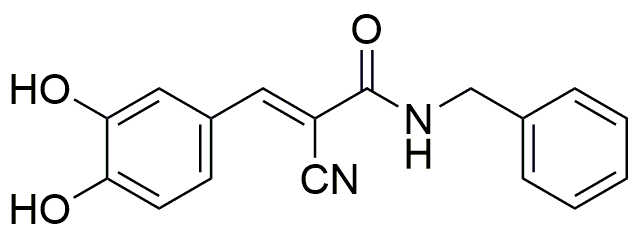Tyrphostin AG 490 is widely utilized in research focused on:
- Cancer Research: This compound acts as a potent inhibitor of specific tyrosine kinases, making it valuable for studying cancer cell signaling pathways and potential therapeutic targets.
- Neuroscience: It has applications in neurobiological studies, particularly in understanding the role of growth factors in neuronal survival and differentiation.
- Diabetes Research: Tyrphostin AG 490 is used to investigate insulin signaling pathways, helping researchers explore new treatments for insulin resistance and diabetes.
- Inflammation Studies: The compound is effective in examining the mechanisms of inflammation, providing insights into chronic inflammatory diseases and potential interventions.
- Drug Development: Its ability to modulate kinase activity makes it a useful tool in the development of new drugs aimed at various diseases, including those related to cell growth and proliferation.
General Information
Properties
Safety and Regulations
Applications
Tyrphostin AG 490 is widely utilized in research focused on:
- Cancer Research: This compound acts as a potent inhibitor of specific tyrosine kinases, making it valuable for studying cancer cell signaling pathways and potential therapeutic targets.
- Neuroscience: It has applications in neurobiological studies, particularly in understanding the role of growth factors in neuronal survival and differentiation.
- Diabetes Research: Tyrphostin AG 490 is used to investigate insulin signaling pathways, helping researchers explore new treatments for insulin resistance and diabetes.
- Inflammation Studies: The compound is effective in examining the mechanisms of inflammation, providing insights into chronic inflammatory diseases and potential interventions.
- Drug Development: Its ability to modulate kinase activity makes it a useful tool in the development of new drugs aimed at various diseases, including those related to cell growth and proliferation.
Documents
Safety Data Sheets (SDS)
The SDS provides comprehensive safety information on handling, storage, and disposal of the product.
Product Specification (PS)
The PS provides a comprehensive breakdown of the product’s properties, including chemical composition, physical state, purity, and storage requirements. It also details acceptable quality ranges and the product's intended applications.
Certificates of Analysis (COA)
Search for Certificates of Analysis (COA) by entering the products Lot Number. Lot and Batch Numbers can be found on a product’s label following the words ‘Lot’ or ‘Batch’.
Numéro de catalogue
Numéro de lot/série
Certificates Of Origin (COO)
This COO confirms the country where the product was manufactured, and also details the materials and components used in it and whether it is derived from natural, synthetic, or other specific sources. This certificate may be required for customs, trade, and regulatory compliance.
Numéro de catalogue
Numéro de lot/série
Safety Data Sheets (SDS)
The SDS provides comprehensive safety information on handling, storage, and disposal of the product.
DownloadProduct Specification (PS)
The PS provides a comprehensive breakdown of the product’s properties, including chemical composition, physical state, purity, and storage requirements. It also details acceptable quality ranges and the product's intended applications.
DownloadCertificates of Analysis (COA)
Search for Certificates of Analysis (COA) by entering the products Lot Number. Lot and Batch Numbers can be found on a product’s label following the words ‘Lot’ or ‘Batch’.
Numéro de catalogue
Numéro de lot/série
Certificates Of Origin (COO)
This COO confirms the country where the product was manufactured, and also details the materials and components used in it and whether it is derived from natural, synthetic, or other specific sources. This certificate may be required for customs, trade, and regulatory compliance.

